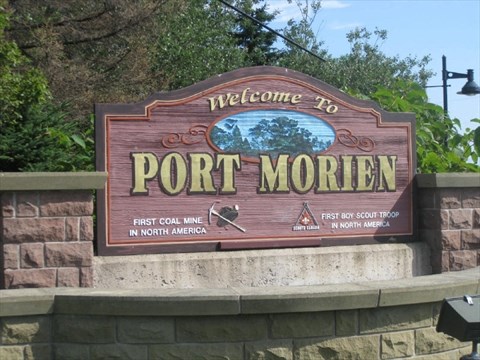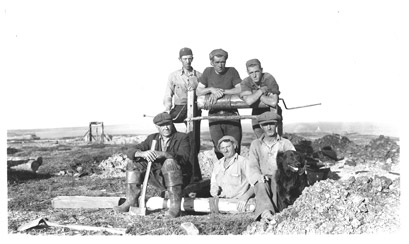Mining is part of #NovaScotia's heritage!
The first commercial #coal mine in North America started 300 years ago in #PortMorien when, in 1720, the French started it to supply #FortressLouisbourg.
This is Port Morien's #mining history.
#nspoli #cbpoli #nsheritageday @NS_Museum #NS


The first commercial #coal mine in North America started 300 years ago in #PortMorien when, in 1720, the French started it to supply #FortressLouisbourg.
This is Port Morien's #mining history.
#nspoli #cbpoli #nsheritageday @NS_Museum #NS



Port Morien’s original French name was Baye de Mordienne but it was changed to Cow Bay in the 1800s. The legend is that a cow escaped from a ship and was found there. The name was changed to Port Morien in 1895.
#nspoli #cbpoli #nsheritageday #capebreton #novascotia

#nspoli #cbpoli #nsheritageday #capebreton #novascotia


1724 - Coal from Port Morien was shipped to Boston in Canada’s first international trade of minerals. Coal was traded for bricks, lumber and provisions.
#nspoli #cbpoli #nsheritageday #capebreton #novascotia
#nspoli #cbpoli #nsheritageday #capebreton #novascotia

1725 - A blockhouse fort was built at the mine to protect it. Mining continued on a fairly regular basis until 1758 when the English captured Fortress Louisbourg. For the next ten years or so the mine produced on a sporadic basis and then fell into disrepair.
#nspoli #cbpoli
#nspoli #cbpoli

1859 – The former Blockhouse site was leased to Marshall Bourinot who sold the lease to New York’s Blockhouse Mining Company in 1863.
#nspoli #cbpoli #nsheritageday #capebreton #novascotia
#nspoli #cbpoli #nsheritageday #capebreton #novascotia

1862 – A slope was opened near the shoreline by T.D. Archibald & Company on the Gowrie Seam. This was the first official record of production from the seam but coal was likely taken from the shoreline outcrop in the 1700s.
#nspoli #cbpoli #nsheritageday #capebreton #novascotia
#nspoli #cbpoli #nsheritageday #capebreton #novascotia

1863 – At the Blockhouse site, coal was being hauled from the Dawson pit located near 6 Mines Road (present day baseball field) to #Donkin.
#nspoli #cbpoli #nsheritageday #capebreton #novascotia
#nspoli #cbpoli #nsheritageday #capebreton #novascotia

The Dawson pit was mainly used to bank coal during winter, while in summer most coal was hauled directly to a pier. Many piers had to be repaired or reconstructed over the life of the mine due to the fierce winter weather conditions along the shoreline at this location.
#nspoli
#nspoli

It was noted as early as 1863 that considerable trouble was encountered with water seeping into the mine due to surface subsidence.
A shaft known as the Odiorne Pit was started in 1863 on the site of what would later be a number of beehive coking ovens at Morien.
#nspoli #cbpoli
A shaft known as the Odiorne Pit was started in 1863 on the site of what would later be a number of beehive coking ovens at Morien.
#nspoli #cbpoli

A small mine known as the Mira Bay Colliery was opened at Waddens Cove near Homeville on the Tracy Seam.
1864 – The Caledonia Mine was opened by a man named Wilson at Baird Cove, south of Port Morien on the opposite side of Morien Bay from the town.
#nspoli #cbpoli #nsheritageday
1864 – The Caledonia Mine was opened by a man named Wilson at Baird Cove, south of Port Morien on the opposite side of Morien Bay from the town.
#nspoli #cbpoli #nsheritageday

1866 – The Caledonia Mine was now called the South Head Colliery. Over the course of its life, numerous wharfs were constructed and destroyed by rough seas.
The Mira Bay Colliery was closed.
1867 – Production on the Gowrie Seam was primarily from the Odiorne Pit.
#nspoli #cbpoli
The Mira Bay Colliery was closed.
1867 – Production on the Gowrie Seam was primarily from the Odiorne Pit.
#nspoli #cbpoli

1871 – The Blockhouse mine was closed for most of the year due to a storm destroying the shipping facilities. Mining then continued but water troubles associated with surface subsidence plagued operations.
#nspoli #cbpoli #nsheritageday #capebreton #novascotia
#nspoli #cbpoli #nsheritageday #capebreton #novascotia

1872 – A shaft was started nearly 1.4-kilometres to the West of the Odiorne Pit to work the Westerly portion of the Gowrie seam near present day Morien Junction.
1877 – After 14 years of sporadic production, the South Head Colliery was closed.
#nspoli #cbpoli #nsheritageday
1877 – After 14 years of sporadic production, the South Head Colliery was closed.
#nspoli #cbpoli #nsheritageday

1882-82 – The Blockhouse Mining Company sank a shaft 250 feet to the Gowrie seam just west of the present-day Bell Aliant building on the north side of town. It was abandoned due to equipment troubles.
Check out part 2 tomorrow…
#nspoli #cbpoli #nsheritageday #capebreton
Check out part 2 tomorrow…
#nspoli #cbpoli #nsheritageday #capebreton

• • •
Missing some Tweet in this thread? You can try to
force a refresh



























